2015 Darwin Science Expedition - Day 14 Mapou overnight & camera recovery
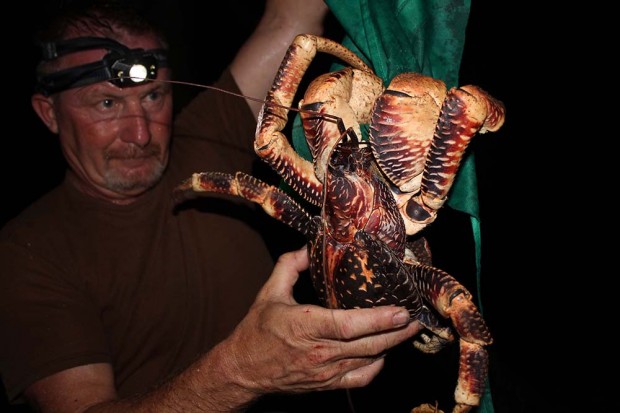
So to report on last nights activities I think it best to hand over to Pete – needless to say I was impressed to see a coconut crab of 2,5kilogram tip our scales during the transects we conducted! Pete has written up his activities of the last few days and they follow my short report for today. The moon is on the wax at the moment and offered bright light whilst we were out of the trees on this island. A great opportunity to do some moonlight photography (not to mention the sunset being beautiful!).
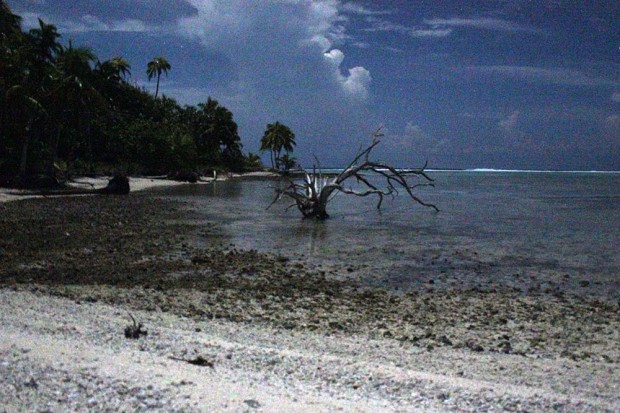
My day started with a dive to recover John’s camera set up this morning after it had broken its tether and fallen to the depths at the end of his dive. Lucky for us Anne spotted the glint of sunlight off the camera's housing toward the end of the search and we came back successful!
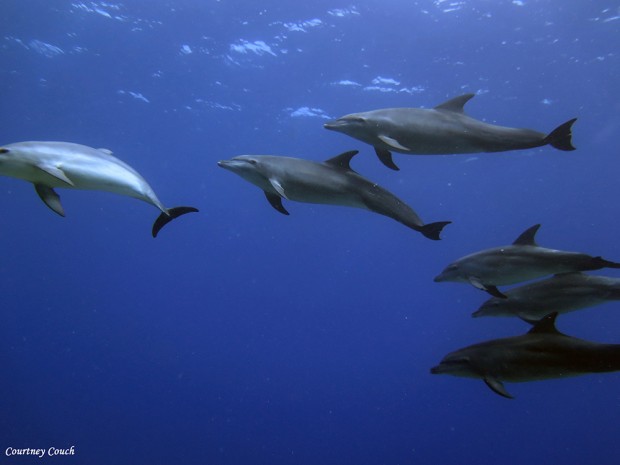
Whilst we were out searching for it the crew that headed Oceanside to survey the reefs off Ile de la Pas had a treat as a pod of bottlenose dolphin passing by stopped to investigate them at work. Whistling and swiftly circling the survey crews they distracted everyone for a couple of minutes before their curiosity was satisfied and they swam off into the blue.
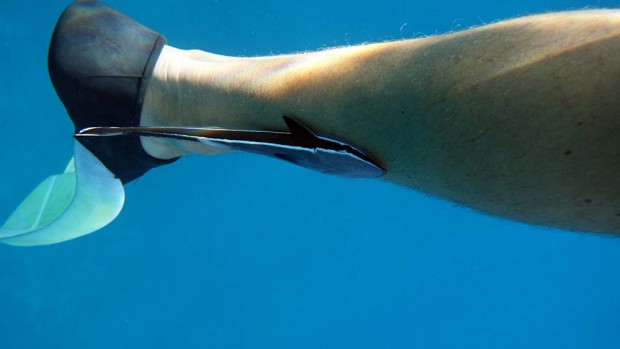
My own little treat on the camera recovery dive was a small remora that discovered me midway through. He decided my legs would be a great place to attach and I ended up with a companion glued to my legs for the remainder of my time underwater. In fact he only left my leg when I was climbing onto the boat and his head lifted above the sea surface. Disappointed at my disappearance he swivelled sharply and wiggled into the depths.
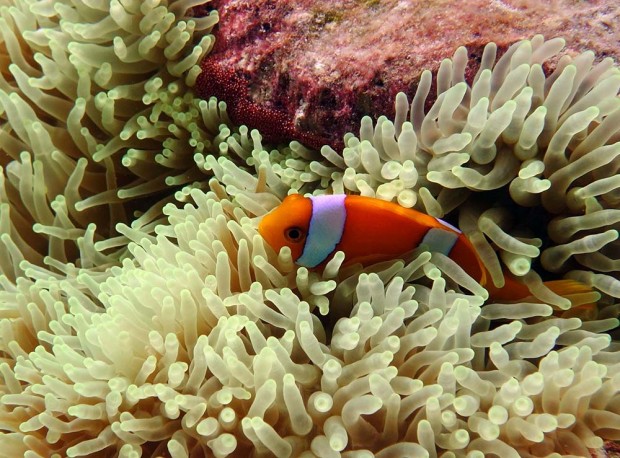
The afternoons dive was off the islet of du Sel on the southern edge of the atoll. Here there was a precipitous drop off starting at 12 meters. I enjoyed the sight of an unusual anemone with two chagos anemonesfish bringing some extra colour to this white tentacled beast. If you look carefully at the photograph you can see that they have laid eggs which are clustered on the edge of the rock above the centre of the frame.
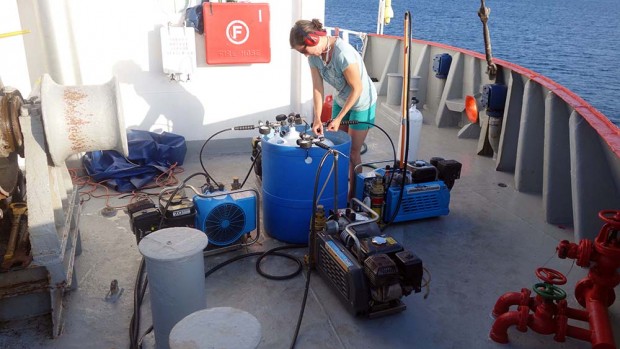
Filling dive tanks is part of our daily routine out here…back to it! More from Pete below...

Having a protracted stay in the Salomons allowed me to pursue various ongoing projects. First, of course, was the breeding seabird survey. As this atoll is small, it is thought that all but two of the larger islands are rat-infested (read on) and the two largest islands are former plantations where coconut chaos now reigns throughout, the bird survey work would not take too long. This meant I could concentrate on Coconut Crab surveys and the long-running rat question of this atoll and that is, “are rats present on Ile de la Passe?”
There is of course some history behind this simple rat question. In 1996, the person who conducted the first comprehensive breeding seabird census also conducted a rapid assessment of the archipelago for rats. This excellent baseline study has since been compared against (breeding seabird populations), expanded upon (new species of seabirds found breeding) and amended (what islands have rats or do not have rats). For one person to assess an entire archipelago with some 55 islands in six weeks for seabirds and rats was a Herculean task and it is no surprise that some of the neophobic rat assessments, after the luxury of checking over several years, have proved to be incorrect. The original survey stated that all of the islands in Peros Banhos (with the exception of the rocky Coin du Mire) and the Salomons were rat-infested. This would be a fairly logical conclusion due to human disturbance but, it has been proven wrong over time. The six proposed and designated IBAs of Peros Banhos have all been revised as having no rats and of course, it appears Vache Marine has now joined this elite club. In the Salomons, after three years of observations and several nights of trapping I was confident enough in 2011 in the journal British Birds to say that Mapou was rat-free and this was confirmed by the eradication expert who joined us on the Vache Marine project in 2014. I also tentatively suggested in 2011 that Passe may be rat-free. Having spent many nights rat trapping on Passe with (fortunately) no success and now having vastly more experience of rat detection having worked with an eradication expert for a month in the Chagos, I was determined to gather enough information on this trip to combine with my previous research, to say once and for all, if Ile de la Passe is in fact rat-free.

But first the breeding seabirds. Mapou was the target island for the morning of day one and a count of all the seabirds on this island is relatively straightforward. It was pleasing to note that breeding Lesser Noddy numbers in the Intsia bijuga (a tall, straggly, native, climax forest tree) stand in the centre of the island are reaching four figures and huge Coconut Crabs are still roaming this small but impressive forested island. Two more nesting Red-footed Booby were individually marked (one ringed by Claudia, not bad for a first bird ringed!) and had trail cameras mounted nearby to monitor their parental movements. It was satisfying that one bird when released flew out to sea and turned straight back and was alongside its chick within two minutes, just above our heads. The afternoon was spent on Passe, checking for breeding seabirds and, as mentioned above, doing a lot of detective work to try and prove the rat case one way or the other. The traps have been set, and now time, diligence and hard work will tell!
Over the ensuing days in the Salamons every island was surveyed for birds. With the caveat that the breeding season lasts all year for most of the breeding seabirds in the Chagos and therefore all we are gaining is a snapshot, not the whole picture, the seabird populations of this atoll appear to be healthy and maintaining their numbers. The trail cameras mounted over the marked individuals’ nests were successful in producing a time-series of photographs of which of the parents were attending the nests. The photographs also confirmed the brief visual observations of these nests that I was able to make over our stay.
Two islands were surveyed at night for Coconut Crabs. This IUCN Red Listed species, the largest arthropod in the world, is declining globally through harvesting by man for food. In captivity it is proving to be extremely long-lived but difficult (if not impossible) to breed. This means there is no safety net for this species, once it has been harvested to extinction, it will be gone. This has already happened at all of its (former) mainland sites and it is now restricted to oceanic islands. The Coconut Crabs in the Chagos are thought to be one of the few (only?) non-harvested populations in the world. This is paying dividends as recent research on Diego Garcia has revealed Coconut Crabs at the highest density per hectare on any island researched to date. My task in the northern atolls of the Chagos was to gather initial data on these out-lying populations such as, which islands are they on? In what numbers? Do they have habitat or soil preferences? All information required for management of the species within the Territory.

So, once darkness had descended Jon Schlayer and I started our work. Walking along a predetermined length line, measuring the distance away from the line to any crabs we encountered. These specimens were then sexed, had their carapace measured and their mass taken. Combined with island size and what habitat the crabs were noted in is allowing a picture of their distribution and abundance to be built up and critically, what their habitat preferences are at the various life stages. For such a well-harvested beast, there has been surprisingly little published on their life history and it is hoped our research will increase our knowledge and ability to protect and conserve this unique and incredible member of the crab family.
So back to rats. In August 2014, two tiny islands of this atoll, Sel and Jacobin, had rat eradications conducted on them. This was part of an experiment to assess if (or how long until) rats cross water to other islands. Overnight trapping on these two islands has led me to conclude that at least after seven months, they have remained rat-free. And what of the Passe question? However much I would love to declare 100% that this island was rat-free, I believe it is too big and my research not enough, yet, to lay my neck on the line and say it is rat-free. What I will say is all the indications are that, (miraculously if true), this island is rat-free.

My final memories of the Salomons is not of the beautiful sunsets or the idyllic looking islands circling the atoll rim, nor the hundreds of birds rising from the tiny, forested island of Mapou at dawn or the huge, unearthly Coconut Crabs clattering around the former coconut plantations in the darkness on Anglaise. It is of a Green Turtle that should be called Lucky, or maybe even Super Lucky. The Salomons atoll is very seldom visited and of those who do visit very few make it ashore, let’s say less than 100 people per year set foot on land there. Of those 100 people, 95 of them will only land at the old Plantation Headquarters on Boddam. Of the remaining five people, three may land on Anglaise and of these two may go around the islands’ shoreline both lagoon and ocean-side. And, they may do this at a maximum twice a year.
“Super Lucky” the Green Turtle had been caught in a net under a Fish Aggregating Device (FAD). The FAD had been washed ashore on the ocean-side of Ile Anglaise. In fact it had been washed ashore about 15 minutes before we walked along this section of the coastline. Super Lucky was tangled by the netting so badly it would never have freed itself. Struggling in the sun I guess it would have desiccated, dehydrated and died within an hour or two. So, what were the odds on that turtle being washed up on that tide at the time peoplewho would free it were walking around one of the least visited islands in the remotest part of the central Indian Ocean? Pretty slim I think! However, Lucky did live to swim in the oceans again and Claudia who released it back in to the water thought she had won the Jackpot too!


